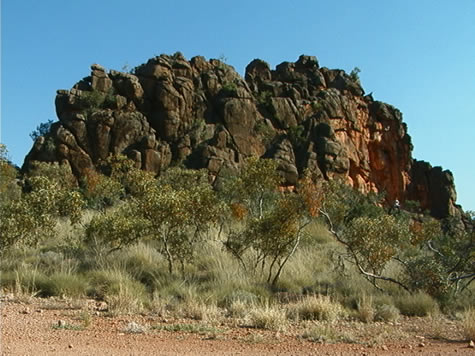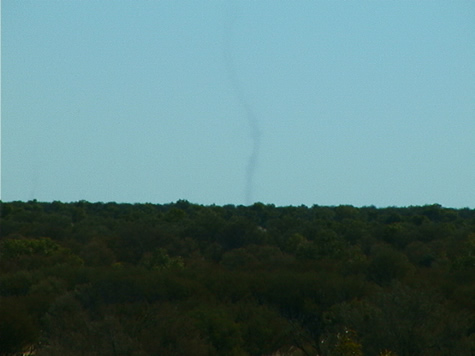2001 September 4, Tuesday. Alice Springs.
Our visit to Corroboree Rock this morning taught us about the
connection between the land, aborigines, and their dreaming stories. The
Australian Aboriginal equivalent of the creation story is the Dreamtime. Stories
from the Dreamtime tell of their ancestors and of how the animals and
the shape of the land came to be the way they are today.
Story telling is a central part of aboriginal culture, and includes the
dreaming, stories to teach children, and stories told for
entertainment.

Each tribe tells stories using the features of the environment in which
they live. Tribes living near ghost gums tell why the tree trunks are
so white. Those living in the mountains explain how they became so high. A
tribe living near quicksand will tell a story to their children to warn
them of the dangers of going too close to it.
The Eastern Arrente tribe, who lived in the area around Corroboree
Rock, tell a story about a monitor lizard – the perentie - because many
monitors inhabit that country.

In the flatter desert country, the wind whips across the open land,
creating miniature whirlwinds, or willy-willies. A traditional story
from Areyonga, in the Northern Territory, incorporates a willy-willy,
which the tribe calls a kupi-kupi, and warns of the danger of snakes.
It also tells of the importance of family, teaches a way to cure fever,
and warns of the dangerous nature of snakes. It goes like this:
“There was once a girl who loved to chase the kupi-kupis as far as she
could run. One day an enormous kupi-kupi came, and as she tried to
chase it, it lifted her off the ground and away. When the girl’s parents came
home they found she was gone, and suspected what had happened. They
were so sorrowful that they moved far away to other lands.
The witch doctor thought maybe the wanampi – the water snake – had
taken her, and sent a man out to search for her by the waterhole.
She was there where the kupi-kupi had dumped her – sitting by the
waterhole and hitting the ground with her story stick telling stories
to herself. She was lonely for her country. She saw the man that the witch
doctor sent waving to her, and walked towards him, but the wanampi
pulled her back. She disappeared into the water.
The next day the man returned, and found her sitting near the sleeping
wanampi. He waved again. Quietly, the girl got up and ran to the man
while the wanampi slept. He began to carry her back to her parents.
When wanampi woke to find the girl had gone, he was so angry that he
sent a flood over the country to find her. When the flood couldn’t find
her it returned to the waterhole.
The man and girl travelled a long way, until they came to a place where
all the people were living. Her mother and father were delighted to see
her, but the girl was very sick and sweating.
Her mother made a fire, and piled leaves on to make smoke. Then she put
the leaves on her daughter’s body. The girl became well again and
married the man
Write your own dreaming story. Try including some of the following: Why
is your home place the way it is? What are the birds saying as they
sing in the mornings? How do you celebrate happy times? How do you cope with
sorrowful times? What are the best things to play with in your
favourite space? What dangers are found near where you live?
bel